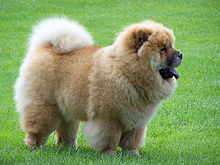Owning and interacting with pets, according to studies, can be a form of therapy for many. We have dedicated Saturday to dogs and Wednesday to cats, when we will post an article on each of those days. We will also post articles on occasion about other animals people may have as pets. – Editorial Team
Analysis of Keeshonden and Chow Chow Dogs – Discussing the Similarities of Their Life Spans, Health Traits, Similar Forms and Similar Functions

Photo source Wikipedia under Creative Commons License.
Thesis Statement: Despite having different histories and demeanors, Keeshonden and Chow Chows both have similar life spans and health traits, and both share similar forms and are also capable of performing similar functions.
I.History.
A + B. Keeshonden and Chows have different histories.
1. The exact origins of both are unknown and have been lost in time.
2. Keeshonden were well established in Holland, while Chows have been known in China for centuries.
3. Keeshonden were used as watchdogs on river barges, while it’s commonly known that Chows were used as food by Mongolians and Mandarins.
4. Keeshonden were disposed of because of their affiliation with a failed political party, while the Chow breed perpetuated by being kept in monasteries and in wealthy households.
5. Chows were recognized by the American Kennel Club (AKC) in 1903, while it took Keeshonden until 1930 to be recognized.
II.Demeanor.
A + B. The demeanor of Keeshonden varies greatly from that of Chows.
1. Chows are reserved and dignified, where Keeshonden are more energetic and playful.
2. Keeshonden tend to be loving and attentive, while Chows tend to be more independent and stubborn.
3. Keeshonden are also very easy going and friendly, where the Chow might be more suspicious and protective.
III. Health traits and life span.
A. Both breeds need similar amounts of activity to stay healthy.
1. Keeshonden need moderate exercise, like taking a brisk walk or engaging in energetic play.
2. Chows also need regular, low-strain, outdoor exercise.
B. Keeshonden and Chows can both live in cold weather.
1. Keeshonden have fur thick enough to keep them warm outdoors in lower temperatures, but they prefer to stay indoors with their family.
2. Chow Chows can also stand a colder environment, do not do well in humidity or warm temperatures, and should be kept indoors during periods of excessive heat.
C. Neither breed has any major health concerns, but both do have a few minor ones.
1. One minor health concern for both the Keeshond and the Chow is Canine Hip Dysplasia, which is commonly referred to as CHD.
2. Another minor concern of the Keeshond is epilepsy; and Chow owners might be slightly concerned with gastric torsion, where the dog’s stomach can twist and sometimes cause death.
D. Both dogs have similar life spans.
1. Chow Chows have a life expectancy average of between eight and twelve years.
2. Keeshonden can be expected to live just a little longer than the Chow, with a life span of just over twelve years.
IV. Form and function.
A. Both breeds are sturdy and square proportioned.
1. The Keeshond stands squarely at around one and a half feet, and its structure helps make it agile.
2. Similarly, the Chow stands between seventeen and twenty inches tall, and its strong build makes it a great hunter and protector.
B. Both breeds are also considered all-purpose or multi-purpose.
1. Neither breed is known to specialize in any particular function.
2. Instead, both breeds are capable of performing quite a few different tasks; and both are known for being protectors.
Conclusion: Pets should be chosen carefully so as to ensure a proper fit into their prospective owner’s lifestyle. Having to choose between these two breeds of dogs can be difficult. Knowing more about their similarities and differences might help make the choice easier.
Analysis of Keeshonden and Chow Chow Dogs
Dogs can make wonderful pets, and while there are hundreds of breeds within many different families of these animals to choose from, not every dog may fit into every individual’s lifestyle. The Keeshond and Chow Chow are two different breeds from the Spitz family of dogs, and both would make a wonderful choice as a pet. When faced with having to choose between either of these dogs though, it is important to have as much information as possible in order to make sure this decision is an educated one. Despite having different histories and demeanors, Keeshonden and Chow Chows both have similar life spans and health traits, and both share similar forms and are also capable of performing similar functions.
Keeshonden and Chow Chows both have very different histories. According to D. Caroline Coile in The Encyclopedia of Dog Breeds, the origins of both breeds are unknown and have been lost in time (1998, pgs. 250, 258). In Dogs, The Ultimate Dictionary of Over 1,000 Dog Breeds, Desmond Morris states that Keeshonden have roots well established in Holland though, while Chows have been known for centuries thousands of miles away in China (2002, pgs. 584, 638). The Keeshond breed is well known by dog enthusiasts as having a history of being watchdogs on river barges, and those same enthusiasts might recall the Chow as being used for food at one time by the Mandarins and Mongolians of ancient China. Eventually over time, as pointed out by Coile, Keeshonden became associated with a losing political party in Holland and were widely disposed of because of this association, while the Chow breed on the other hand was perpetuated by being kept isolated in monasteries and in wealthy households throughout China (1998, pgs. 250, 258). The Encyclopedia of Dog Breeds states that both breeds have been recognized by the American Kennel Club (AKC), as Keeshonden were recognized in 1930, which was decades after the Chow in 1903 (Coile, 1998, pgs. 250, 258). Not only do these breed’s histories differ; their demeanor can be very different as well.
The demeanor of Keeshonden varies greatly from that of Chows. Upon observation, one may find that Chow Chows appear to be reserved and dignified, while the Keeshonden seem more energetic and playful. The Encyclopedia of Dog Breeds rates the Keeshond breed as being more loving and attentive than Chows, who seem to be more independent and stubborn (Coile, 1998, pgs. 250, 258). People familiar with both of these breeds might also identify the Keeshond as being very easy going and friendly in a stark contrast to the Chow’s attitude of suspicion towards strangers accompanied by their protective behavior. The Chow almost seems regal, exuding an air of royalty, while the Keeshond fits more the role of the fun-loving jester. Despite the differences in their demeanor though, either of these dogs would probably make for a great companion over the years.
Both the Chow and the Keeshond have similar life spans and health traits. According to Coile, Chows have a life expectancy average of between eight and twelve years, while Keeshonden can be expected to live just a little longer with a life span of just over twelve years (1998, pgs. 251, 259). Over the course of these dogs’ lives, neither the Chow nor the Keeshond should have any major health concerns, but might experience a few minor ones. Coile notes that one minor concern for both breeds is Canine Hip Dysplasia (commonly referred to as CHD), which is genetic and can cause arthritis in the hips (1998, pgs. 251, 259). Coile also explains that another minor concern of the Keeshond is epilepsy; while Chow owners should be on the lookout for gastric torsion, which is where the stomach can twist and sometimes cause death. In order to stay healthy, both breeds should maintain similar amounts of activity. Keeshond owners familiar with the breed know that these dogs are moderately playful and enjoy taking brisk walks on a leash. Some Keeshonden like to play fetch, and because the breed is so easy going and friendly, most do well with running and playing outdoors in the yard with children. Chow owners can also attest that the breed requires a lot of low-strain, outdoor exercise on a pretty regular basis.
Being outdoors doesn’t necessarily only have to mean fun for these dogs either, as both breeds are capable of healthy living in cold weather conditions. Coile points out that Keeshonden have fur thick enough to keep them warm outdoors in lower temperatures even though dogs of this breed prefer to stay indoors with their family, and that Chows can also stand a colder environment but do not do well in humidity or warm temperatures (1998, pgs. 251, 259). Therefore, Chows should be kept indoors during periods of excessive heat, and should only go out for exercise in the mornings or evenings when temperatures are cooler.
Keeshonden and Chows also share similar form and can perform many of the same functions. Both breeds share a similar stance, making them appear sturdy evenly balanced. Coile indicates that the Keeshond stands squarely at around one and a half feet, and that its structure helps make it agile (1998, pgs. 251, 259). Coile also points out that the Chow stands similarly between seventeen and twenty inches tall, and its strong build makes it a hunter and protector (1998, pgs. 251, 259). Because of their builds, both breeds can be used for many different types of things, and this makes them considered to be all-purpose or multi-purpose. Neither breed is commonly known to specialize in any particular function. Instead, as Desmond Morris points out in Dogs, The Ultimate Dictionary of Over 1,000 Dog Breeds, breeds from the Spitz family are capable of performing quite a few different tasks and are known for being protectors (2002, p.550). So whether they are protecting a royal family or just chasing after a ball with the kids in the back yard, either the Keeshond or the Chow performs these types of tasks with great form and function.
While any dog has the potential to make a great pet, the breed should be chosen carefully so as to ensure a proper fit into their prospective owner’s lifestyle. Having to choose between the Keeshond and Chow Chow might be difficult because, on the surface, they appear to be similar dogs. Knowing some of the similarities and differences between the Keeshonden and Chow though should hopefully make that choice a little easier for any prospective owner.
References
Coile, D. Caroline. (1998). The Encyclopedia of Dog Breeds. Hauppauge, NY: Barron’s Educational Series.
Morris, Desmond. (2002). Dogs, The Ultimate Dictionary of Over 1,000 Dog Breeds. North Pomfret, VT: Trafalgar Square Publishing
Courtesy of Free Content Web.

